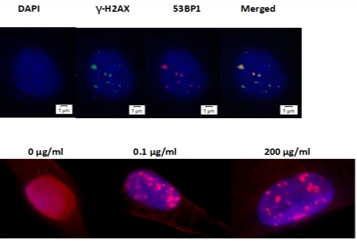Impacts of prolonged exposure to low concentration of titanium dioxide nanoparticles on cell cycle control and DNA repair
Abstract
Although the toxicological profile of titanium dioxide nanoparticles is not fully illuminated, large quantities of titanium dioxide nanoparticles (TiO2NPs) are now produced. In our study, we evaluated the cytotoxic and genotoxic impacts of titanium dioxide nanoparticles on different cell lines (normal, cancer and DNA repair-deficient cells). MTT assay was used to evaluate the cytotoxicity, γ-H2AX and 53BP1 assay was used to evaluate the genotoxicity and G2/M assay was used to study the impacts of titanium dioxide nanoparticles on cell cycle regulation. In this study normal and DNA repair-deficient cell lines were used to study the repair mechanism of titanium dioxide nanoparticles induced DNA damage. G2/M checkpoint maintenance was also evaluated. We demonstrate that prolonged exposure to low concentrations of titanium dioxide nanoparticles does not induce significant cytotoxicity but induces significant genotoxicity, particularly DNA double-strand breaks (DNA DSBs). Furthermore, this study demonstrated that DNA DSBs at heterochromatin region are ATM-dependent and DNA DSBs at euchromatin region are ATM-independent and DNA PKcs dependent. After exposure to titanium dioxide nanoparticles, we show that the activation of G2/M checkpoint is DNA DSBs dependent threshold as does checkpoint release. All in all, we showed that prolonged exposure to low concentrations of titanium dioxide nanoparticles does not affect cell viability but causes DNA damage and cell cycle checkpoint adaptation which may lead to genetic instability.
Downloads
References
2. Rollerova E, Tulinska J, Liskova A, Kuricova M, Kovriznych J, Mlynarcikova A, et al. Titanium dioxide nanoparticles: some aspects of toxicity/focus on the development. Endocr Regul. 2015; 49(02): 97–112.
3. Zhang XZ, Sun HW, Zhang ZY. [Bioaccumulation of titanium dioxide nanoparticles in carp]. Huan Jing Ke Xue Huanjing Kexue Bian Ji Zhongguo Ke Xue Yuan Huan Jing Ke Xue Wei Yuan Hui Huan Jing Ke Xue Bian Ji Wei Yuan Hui. 2006; 27(8): 1631–1635.
4. Johnston HJ, Hutchison GR, Christensen FM, Peters S, Hankin S, Stone V. Identification of the mechanisms that drive the toxicity of TiO2 particulates: the contribution of physicochemical characteristics. Part Fibre Toxicol. 2009; 6(1): 33.
5. Park EJ, Yi J, Chung KH, Ryu DY, Choi J, Park K. Oxidative stress and apoptosis induced by titanium dioxide nanoparticles in cultured BEAS-2B cells. Toxicol Lett. 2008; 180(3): 222–229.
6. Gurr JR, Wang ASS, Chen CH, Jan KY. Ultrafine titanium dioxide particles in the absence of photoactivation can induce oxidative damage to human bronchial epithelial cells. Toxicology. 2005; 213(1–2): 66–73.
7. Zhu Y, Eaton JW, Li C. Titanium Dioxide (TiO2) Nanoparticles Preferentially Induce Cell Death in Transformed Cells in a Bak/Bax-Independent Fashion. Plos One. 2012; 7(11): e50607.
8. Schilling K, Bradford B, Castelli D, Dufour E, Nash JF, Pape W, et al. Human safety review of “nano” titanium dioxide and zinc oxide. Photochem Photobio S. 2010; 9(4): 495–509.
9. Chen X, Selloni A. Introduction: Titanium Dioxide (TiO2) Nanomaterials. Chem Rev. 2014; 114(19): 9281–9282.
10. Jugan ML, Barillet S, Simon-Deckers A, Herlin-Boime N, Sauvaigo S, Douki T, et al. Titanium dioxide nanoparticles exhibit genotoxicity and impair DNA repair activity in A549 cells. Nanotoxicology. 2011; 6(5): 501–513.
11. Weir A, Westerhoff P, Fabricius L, Hristovski K, Goetz N von. Titanium Dioxide Nanoparticles in Food and Personal Care Products. Environ Sci Technol. 2012; 46(4): 2242–2250.
12. Riballo E, Kühne M, Rief N, Doherty A, Smith GCM, Recio MJ, et al. A Pathway of Double-Strand Break Rejoining Dependent upon ATM, Artemis, and Proteins Locating to γ-H2AX Foci. Mol Cell. 2004; 16(5): 715–724.
13. Löbrich M, Jeggo PA. The impact of a negligent G2/M checkpoint on genomic instability and cancer induction. Nat Rev Cancer. 2007; 7(11): 861–869.
14. Stope M. Phosphorylation of histone H2A.X as a DNA-associated biomarker (Review). World Acad Sci J. 2021; 3: 3.
15. Goodarzi AA, Noon AT, Deckbar D, Ziv Y, Shiloh Y, Löbrich M, et al. ATM Signaling Facilitates Repair of DNA Double-Strand Breaks Associated with Heterochromatin. Mol Cell. 2008; 31(2): 167–177.
16. Iliakis G, Murmann T, Soni A. Alternative end-joining repair pathways are the ultimate backup for abrogated classical non-homologous end-joining and homologous recombination repair: Implications for the formation of chromosome translocations. Mutat Res Genetic Toxicol Environ Mutagen. 2015; 793: 166–175.


This work is licensed under a Creative Commons Attribution 4.0 International License.




